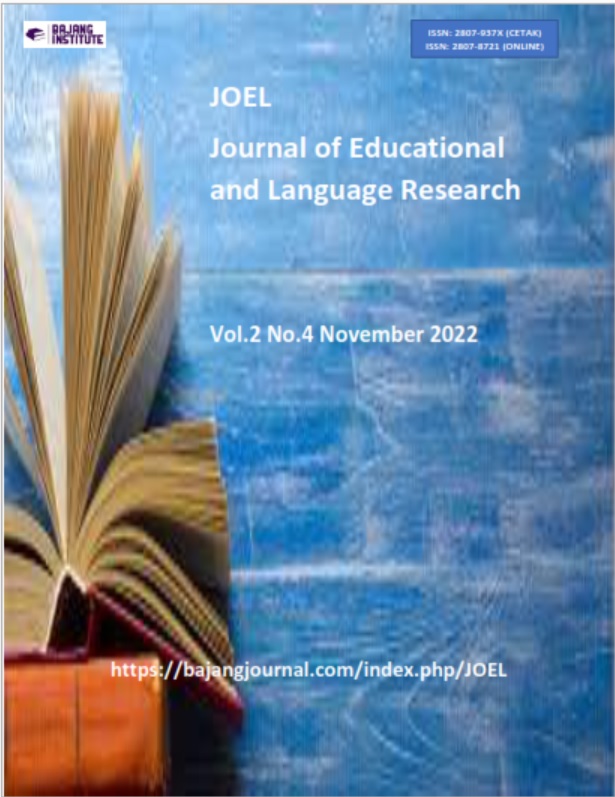TEACHER’S STRATEGIES IN TEACHING WRITING DESCRIPTIVE TEXT AT 10TH GRADE OF SMA NEGERI 5 KOTA SERANG
DOI:
https://doi.org/10.53625/joel.v2i4.4142Keywords:
Descriptive Text,Teaching Strategy,Teaching WritingAbstract
The aim of this research is to investigate the teacher's strategies in teaching writing descriptive text at 10th grade of SMA Negeri 5 Kota Serang. This research applied a qualitative method by using case study design. The required data were collected through observation, interview, and questionnaire. The participant of this research was an English teacher of SMA Negeri 5 Kota Serang. The findings of the data analysis showed that the English teacher in SMA Negeri 5 Kota Serang applied several strategies when teaching writing descriptive text in classroom, such as cooperative learning or discussion, brainstorming, demonstration, and games. Cooperative learning or discussion used as group discussion with 3-4 students, brainstorming as warming up and creates the enjoyment of the class, demonstration as method to demonstrate about descriptive text in general and detail such as grammar and tense, games are used as ice breaking in class for attract the student’s attention. Educational games based on technology were used as strategy. The participant used applications for educational games for adapting to the current situation that requires students or teachers to use technology. However, with these strategies the students can understand the material of descriptive text material optimally, and make the class atmosphere more interesting.
References
Amado, H. (2010). Screenwriting: A strategy for the improvement of writing instructional practices. Profile Journal. (Vol 12, No. 2, October 2010
Applebee, A. N., Langer. J., Mullis. I., Latham. A., and Gentile. C. (1994).NAEP 1992 Writing Report Card. Report No. 23-W01. Washington DC: Office ofEducational Research and Improvement, U.S. Department of Education.
Appel, J. (1995). Diary of a Language Teacher. Oxford: Heinemann English Language Teaching.
Argha Try Prabanto (20170. Teacher’s Strategies in Teaching Writing Narrative Text at SMKN 1 Krismantoro.
Atkinson, P., and Delamont, S. (2006). In the roiling smoke: Qualitative inquiry and contested fields. International Journal of Qualitative Studies in Education,19(6), 747-755.
Bell, J. (1993). Doing Your Research Project. Buckingham, England: Open University Press.
Biggs, J. (2003).Teaching for Quality Learning at University: What the Student Does, 2nd ed, SRHE &OpenUniversity Press, Berkshire.
Bock, L. K. (1979). Teaching Adults in Continuing Education. Illinois: University of Illinois.Booth, D and S, Larry. (2004). Literacy Techniques for ilding Successful Readers and Writers. Canada: Pembroke Publishers.
Brown, Douglas, H. 2001. Teaching by Principles: An Interactive Approach toLanguage Pedagogy. New York: Addison Wesley Longman, Inc.
C. K. (2008). Narrative Methods for the Human Sciences. Los Angeles, California: Sage.Schwandt, T.A. (1997). Qualitative inquiry: a dictionary of terms. Sage.Tylee, J. (1999).
Clay, M. 1991. Becoming Literate: The Construction of Inner Control.Portsmouth, NH: Heinemann.
Cooper, J. D. 1997. Literacy: Helping Children Construct Meaning (3rd ed.).New York: Houghton Mifflin.
Egawa, K. 2001. Writing in The Middle Grades. Language Arts.
Fadholi Ichsan Raharjanto (2016) Teacher’s Strategies in Teaching Writing at MTSN Sukaharjo.
Fauziati, Endang. 2014. Teaching English as foreign language. Surakarta: Era Pustaka Utama.
Freedman, S. W., and Daiute, C. (2001). Instructional Methods and Learning Activities in Teaching Writing. In Advances in Research in Teaching, Vol. 8,ed. JereBrophy. Oxford: JAI Press, Elsevier Science. Freedman, S.W., and Hechinger, F. (1992). Writing Matters. Occasional Paper No. 31 of National Center for The Research of Writing.
Gowder, P. 2016. The Rule of Law in the Real World.New York, Cambridge. University Press.
Harmer, J. (2001). The Practice of English Language Teaching, 391Cambridge University Press. Heckhausen, J., &Farruggia, S. P. (2003). Developmental Regulation Across the Life Span: A Control-Theory Approach and Implications for SecondaryEducation. British Journal of Educational Psychology, Monograph Series II,Number 2 - Development and Motivation, 1, 85-102
Hartono. 2008. Statistik Untuk Penelitian.Yogyakarta: Pustaka Pelajar .2008.SPSS 16.0 Analisis Data Statistik dan Penelitian. Yogyakarta:Pustaka Belajar.
Hartono, Eko. 2006. The Influence of Buble Network Technique Use in Teaching Writing Ability of the Second Year Students of SMAN 2 Benai. Pekanbaru:UIN SUSKA.
Holton, D; Clarke, D. 2006. Scaffolding and Metacognition. Internatuonal Journal of Mathematical Education in Science and Technology. 37 (2),pp.127143.
Hornby. 2000. Oxford Advanced Learner’s Dictionary of Current English. Sixth Edition. New York: Oxford University Press.
Hughes, Arthur. 2003. Testing For Language Teacher. United Kingdom: Cambridge University Press.
Hughey, Jane B. et. al. 1983. English Composition Program, Teaching ESL
Composition: Principles and Techniques. Rowley, Massachusetts:Newbury House Publishers, Inc.
Inayah, Nurul. 2012. EFL Teacher’s TeachingStrategies in Public Vocational High Schools in Singaraja.Bali:Jurnal Ilmiah Pendidikan dan
Irikawati (2017). Identifying Teacher’s Strategies in Teaching Writing at MA Nuruttaqwa Limboto.
Pembelajaran Ganesha, Universitas Pendidikan Ganesha.(Accessed on 6th February 2019).
Moleong, L. J. 2001. Qualitative Research Methodology. Bandung: Teenager Rosdakarya.
Moleong, L. J. 2002. Metodologi Penelitian Kualitatif. Bandung: PT.remaja Rosdakarya.
Nemoto, T., & Beglar, D. (2014). Developing Likert-scale questionnaires. In N. Sonda & A. Krause (Eds.),JALT2013 Conference Proceedings. Tokyo: JALT.
Nunan, D. (2003). Practical English Language Teaching. Mc Graw Hill: United Stated. Oates, L. C. (2000). Beyond Communication: Writing as a means of learning. The Journal of Legal Writing Institute. University of Seattle, Vol 6 (1), pp 1-25.Raimes(1983) techniques in teaching writingRiessman,
Teacher as Facilitator: One of the face to face teacher’s roles. Retrieved November 12, 2011
Wallace, T., Stariha, W. E., and Walberg, H.C. (2004) .Teaching Speaking, Listening, Writing. The International Academy of Education: Curtin UniversityPress.
Walvoord, B. (1985). Writing: Strategies for all disciplines. Englewood Cliffs, N.J.: Prentice-Hall.
Wilson, M. (2005). Constructing measures: An item response modeling approach. Mahwah, NJ: Erlbaum.
Wolfe, E. W., & Smith, Jr., E. V. (2007). Instrument development tools andactivities for measure validation using Rasch models: Part I— Instrumentdevelopment tools. Journalof Applied Measurement,8,97- 123.
Yamaguchi, J. (1997). Positive versus negative wording. Rasch MeasurementTransactions,11(2),567.
Downloads
Published
How to Cite
Issue
Section
License
Copyright (c) 2022 JOEL: Journal of Educational and Language Research

This work is licensed under a Creative Commons Attribution 4.0 International License.











